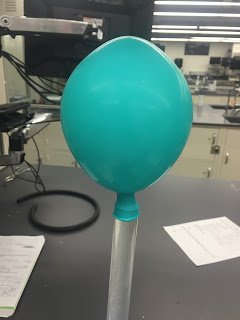In today's episode of Lab Escapades, the Probe Buddies take on carbon dioxide emitting solutions and balloons! The goal of the lab was to collect the gas emitted from a sample of Alka Seltzer, and using the ideal gas law, we determined the mass of gas produced. First, we ground up the alka seltzer tablet using an old-fashioned mortar and pestle, and then poured it into a deflated balloon. Then we attached the balloon to a water-filled graduated cylinder, and the fun began! When the two substances mixed, an abundance of fizzing occurred, and then the balloon filled with CO2 gas emissions, until it looked like this!

After measuring the circumference of this balloon, we emptied its contents and refilled it with water until the balloon reached the same circumference as before. Then we measured this amount of water with a graduated cylinder to find the volume of the gas emitted. Once had all our collected data (shown below), we had many calculations to do using the law of ideal gases.
Analysis Questions:
- Experimental error may have occurred in this lab when we accidentally spilled a little bit of Alka Saltzer when we tried to put the powder into the balloon. More error probably occurred because our slightly inaccurate measuring skills in measuring the amount of water and circumference of the balloon. We could also have accidentally not correctly massed the alka seltzer with the temperamental scales.
- Our yield of CO2 would have been less than normal because we spilled some of the alka seltzer powder while we were pouring it into the balloon. That made our "n" number of moles of CO2 too small.
- circ = 35.5 cm
35.5 = 2πr
5.65 = r V = (4/3)π16.96 V = 755.5 mL
4. The pencil and paper calculated volume is a little over 100 mL less than the water balloon volume measurement. The physical water balloon measurement should be more accurate because our balloon was not a perfect sphere, but a warped oblong shape. The calculated volume called for a perfect sphere that we did not have in real life.
5. Two differences between real gases and ideal gases are that
- real gases have IMFs, but ideal gases don't
- ideal gas has no mass, but real gas does
6. The CO2 we collected would not be considered ideal. The CO2 gas contains the CO2 molecules, there are intermolecular forces because all molecules have London Dispersion Forces. We also determined the volume of the CO2 gas, and ideal gases do not have volume so we know that it is real.
Advanced Questions:
- The mass of CO2 that should have been collected is 2.06 grams. I found this out by using stoichiometry with the gases and by finding out that the limiting reagent is citric acid.
- The percent yield for the CO2 collected in our sample: 1.56g / 2.06 g x 100 = 75.73%
- Our calculated "n" value would be less than the actual amount of CO2 available because some of it dissolved into the water due to the high solubility around room temperature of 90 mL/100mL of water. Unfortunately, we were unable to measure the CO2 that dissolved in the balloon water.



No comments:
Post a Comment